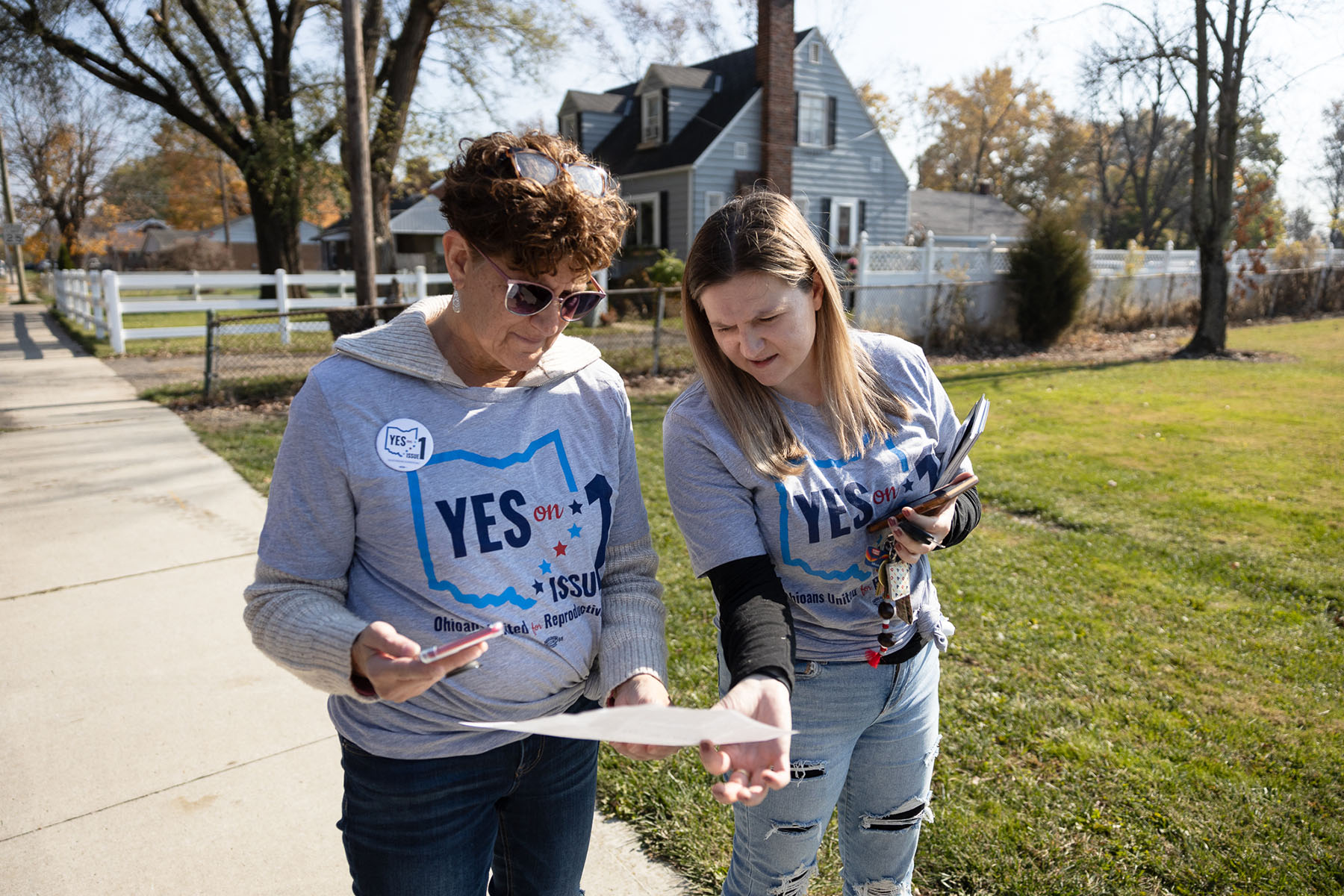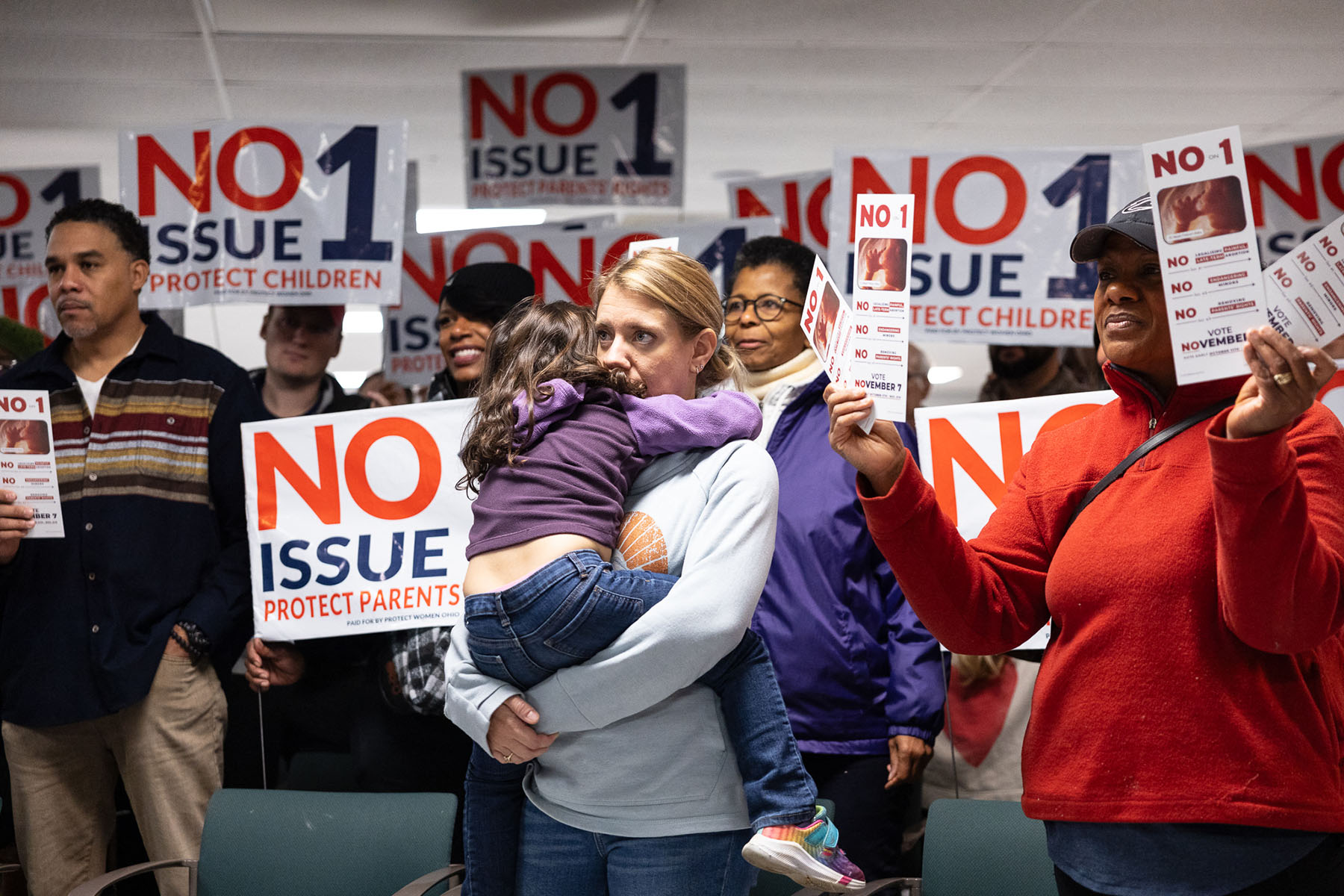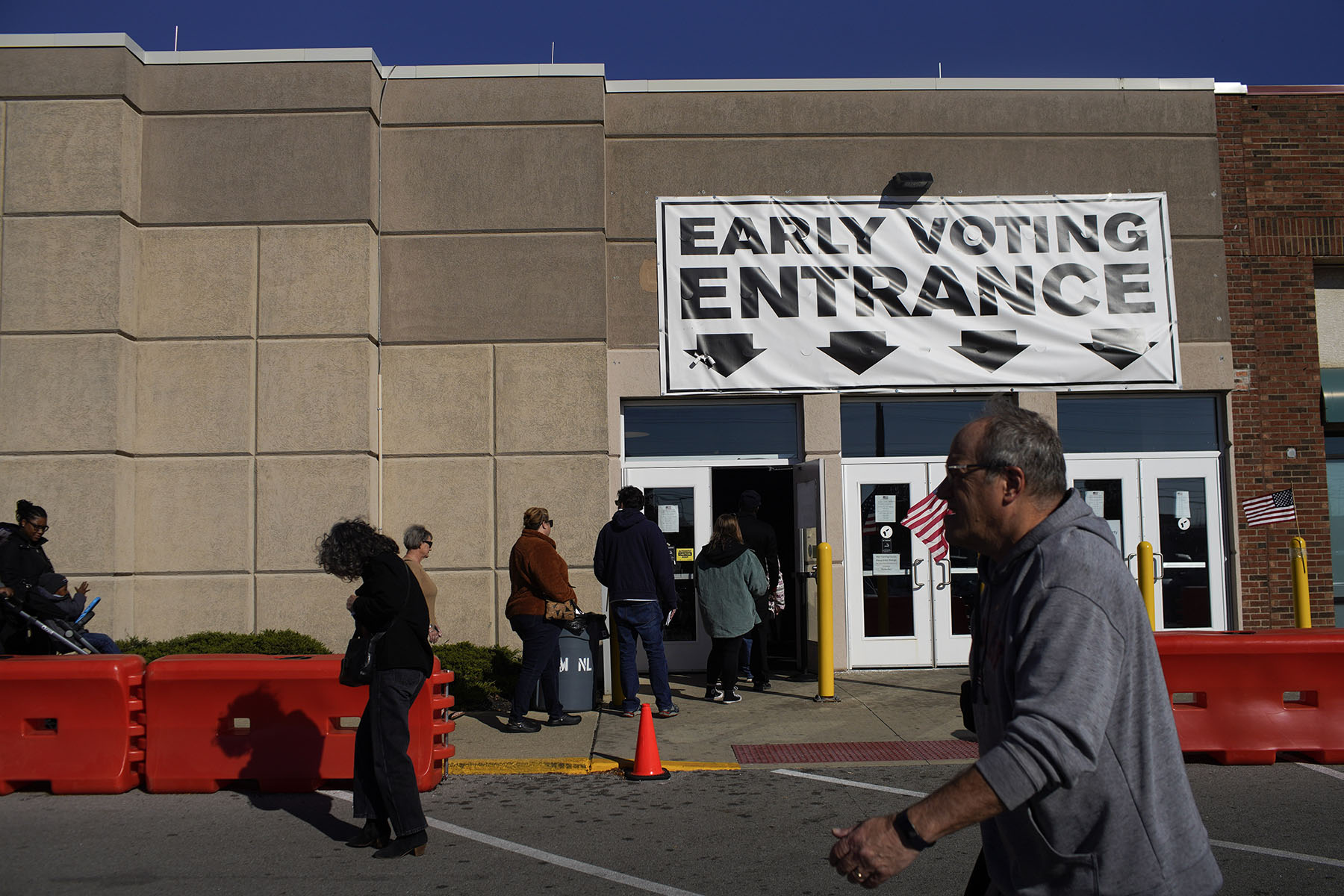Ohio voters passed the Issue 1 abortion ballot measure. See the results here, and sign up for our daily newsletter.
CLEVELAND — The Cuyahoga County Board of Elections office was bustling Saturday, the second to last day of early voting, as workers gave out stickers to kids, rang a bell to celebrate first-time voters and checked in Ohioans casting an early ballot.
Among those in line to vote on a highly watched statewide ballot measure that would guarantee a right to abortion and other reproductive health care in the state Constitution was Katie Paris, the founder of Red, Wine and Blue, a nonprofit organization connecting and mobilizing suburban women around the country around progressive policies. After months of working to pass the constitutional amendment, Issue 1, it was finally Paris’ turn to cast a ballot.
In the living room of her home in the Cleveland suburb of Shaker Heights later, Paris reflected on an “emotional” experience voting in an election that to her and for many on the left is about far more than abortion.
-
Issue 1 Results:
-
Issue 1 Results: Ohio votes to guarantee abortion rights in its state Constitution
For over a decade, Ohio Republicans have passed dozens of restrictions on abortion, including a six-week abortion ban signed into law in 2019 that’s currently on hold in courts. It’s a red state — Ohio voted for former President Donald Trump by eight points in 2020 — and Republicans have used wins to consolidate power and gain a legislative supermajority through partisan gerrymandering of voting maps. For many abortion rights advocates and progressives, the fight over Issue 1 is as much a referendum on abortion as it is on Ohio’s democracy itself. And they aren’t shying away from framing the stakes of the vote in stark terms.
“This is the people versus disinformation; it’s the majority versus government disinformation,” said Paris. “So it’s a real test for not only reproductive rights but our democracy.”
On the one hand, Paris felt gratified by casting a vote for an abortion rights measure she supports instead of fighting against a measure like the one Ohio Republicans put on the ballot in August that would have made the amendment harder to pass.

But she felt dismayed at what information was being presented about the amendment in signage displayed at the polls. The actual text of the amendment is short, just over 200 words long. But the Republican-backed ballot summary language, which is about as long, leaves out what specific forms of health care the amendment would protect and uses language critics have decried as biased. Below are official arguments presented for and against Issue 1, the latter of which make misleading and unsubstantiated claims about what the amendment would do on abortion. And below both was the text of the amendment itself.
“You see people walking by, and of course, they’re looking at it, reading, and it’s just — I hope we’ve done enough,” she said.
In August, Ohio voters overwhelmingly rejected Republicans’ attempt to raise the threshold to pass citizen-initiated constitutional amendments, an effort squarely aimed at thwarting the abortion vote.
GOP Secretary of State Frank LaRose, a top backer of the August vote and 2024 Republican candidate for U.S. Senate, lost in the August special election. But he successfully worked to replace the word “fetus” with “unborn child” in the amendment’s summary language that appears at polling places. The summary also does not state that the amendment would guarantee a right to contraception, miscarriage care and fertility treatment, an omission its proponents argued was designed to hinder its support.
-
Learn More:
Elected Republicans have also exerted control over the flow of information surrounding the ballot measure. The attorney general’s office published a legal analysis that a former Democratic attorney general and attorney general candidate rebutted as flawed and misleading. And state Senate Republicans include misinformation about abortion on a taxpayer-funded website that online search engines promote as an authoritative source. The GOP state Senate, which runs the website, slammed an Associated Press article on the website as a “hit piece” and “woke censorship.”
“The disinformation and misinformation — that is a hallmark of the Ohio Republican Party,” Democratic Rep. Emilia Sykes, the former Ohio House minority leader, said after speaking at a Saturday morning rally in Akron. “They have been doing this for a very long time. They cannot win on their own merits — they have to cheat to win.”
Opponents have argued in ads against the amendment that it would allow for unlimited abortions through all nine months of pregnancy. The amendment allows for restrictions on abortion after the point of fetal viability, and abortions later in pregnancy are already rare: Ohio state health data from 2022 shows nearly 90 percent of abortions were before 12 weeks. The official opposing arguments presented by three Republican state lawmakers claim that the amendment “ends parental notification” and allows abortion “after a child is born alive,” claims legal and policy experts say are misleading or unfounded.
Abortion rights advocates are 6-and-0 with ballot measures around the country since the Supreme Court overturned Roe v. Wade in June 2022. Ohio is not only the first Republican-leaning state to vote on affirmatively guaranteeing abortion rights in its state constitution but also the first where advocates are fighting state leaders who are using the power, resources and influence of their offices to tip the scales.
“I don’t think the obstacle here is that we live in a state that voted twice for Trump,” Paris said. “I think the obstacle is that we live in a state that is controlled by politicians who think that they know better than we do when it comes to the most personal decisions we can make in our lives, and they are the ones who control what language gets on the ballot and what language is on the wall as people walk to vote.”
Republicans holding the August vote also had muddied the waters in November: Both are called Issue 1, but the pro and anti-abortion forces are on opposite sides.
Paris has focused on training Red, Wine and Blue members to feel confident and empowered to push back on misinformation in real-time and answer sincere questions about the amendment. Red, Wine and Blue has also made yard signs and bumper stickers that say: “This time, vote Yes on Issue 1.” Still, she says, the ballot summary language and a slew of false and misleading information has “had a real impact,” even though the text of the amendment is displayed at voting sites.
“I think that it’s what’s making it competitive. I think it’s going to be close,” she added. “And I don’t think it would be close if people were just allowed to know the facts — and by the facts I mean, the actual language of the constitutional amendment.”

Ainslee Johnson-Brown, the Ohio policy and movement building director for Unite for Reproductive and Gender Equity (URGE), part of the Issue 1 coalition, said Ohio Republicans’ push to kneecap direct democracy in August while holding supermajority control of the legislature and most statewide offices “really rubbed a lot of people the wrong way.” The vote wasn’t partisan: The August amendment failed by a margin of 14 points thanks to Republican voters and counties that voted for Trump joining with Democrats and independents to squash the measure. Advocates also want a cross-partisan victory in November.
“Ohioans across the board got really pissed,” Johnson-Brown said in an interview Saturday in downtown Cleveland. “Regardless of where they fall in this particular issue, there is a certain grit to an Ohioan. I think that where we’ve had a lot of success in framing Issue 1 has been on bodily autonomy — we don’t want anyone coming and telling us what to do.”
And Ohio advocates, she said, “definitely don’t want to be the first to lose.”
Sykes sees the abortion vote as not just a fight over reproductive rights and democracy in Ohio but a crossroads that will determine the state’s direction.
“Issue 1 is going to be the guarantee of progress in the state or show that we’re just moving backwards,” she said. “Our state is getting older. The brain drain is very significant. People are fearful to live here. We’re having a hard time with medical residents wanting to be here.”
Two of Sykes’ House Democratic colleagues, Reps. Sara Jacobs of California and Jasmine Crockett of Texas, joined her to rally supporters and canvass voters Saturday. Jacobs argued reproductive rights are a “kitchen-table issue” and an “issue of fundamental rights” from coast to coast.
Crockett reminded rally attendees that the Roe v. Wade decision itself originated in Dallas, which she represents in Congress, and warned them not to go down the path Texas has taken in banning abortion.
“If we don’t start educating people about the intersectionality of this issue and make them recognize that this is a freedom issue, period, then we are all going to lose,” Crockett said at the rally. “This isn’t about whether or not you have a uterus, whether or not you even believe in reproductive access. This is about freedom.”
National advocates and strategists including Mini Timmaraju, president of Reproductive Freedom for All, the group formerly known as NARAL, are closely watching the results in Ohio, as well as state legislative elections in Virginia and a state Supreme Court race in Pennsylvania, where Democrats have centered abortion as a critical campaign issue.
“The outcome in Ohio, specifically, is going to be a bellwether for us in many ways to see how much voters see through the misinformation, the disinformation and the lying tactics,” Timmaraju said on a Thursday call with reporters. “We’re hoping to come out of Ohio, Virginia and Pennsylvania with a clear national message that abortion on the ballot wins, that voters are smart and don’t try to fool them and trick them.”
If advocates in Ohio are successful, they could provide a roadmap for similar efforts in purple and red states on how to overcome legal and political roadblocks posed by elected officials and successfully navigate an environment rife with misinformation.
Sykes said that she’s been sharing strategies and offering support to Rep. Lois Frankel of Florida, the chair of the House Democratic Women’s Caucus, as Florida advocates seek to put a similar abortion rights amendment on the ballot in 2024. Florida’s attorney general is attempting to keep the amendment from making it before voters in the state.
In Ohio and beyond, Paris hopes voters will send a clear message of taking back control over their bodies, their families and their lives.
“This is about so much more than abortion,” Paris said. “It’s about more than reproductive rights. This, too, is about: ‘Will the majority be able to be heard?’”









